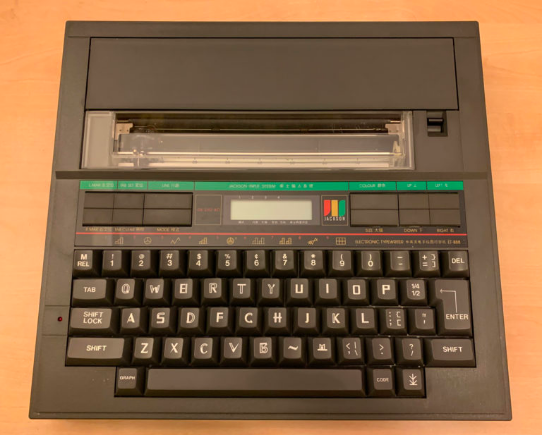Another chapter in the history of the Chinese typewriter
« previous post | next post »
Brian Merriman ran into this article and device when researching electronic typewriters from the 1980s:
It looks a bit like the famous little Sharp typewriter that Zhou Youguang helped design and used to write all of his articles and books from the 80s until his death on January 14, 2017 at the age of 111.
This Fortec ET-888 uses a custom shape-based input system ("Jackson Input System") and employs a plotting device to output characters. It can write ~7k different characters. Though it looks like a typewriter, it is more of a word processor and pen plotter in the form of a typewriter.
You can see it plotting in this video.
For more detailed information about the specifications of the Fortec ET-888, see this article by Keith Tam:
"A bilingual typewriter with a plotter mechanism", (non)material text (4/19/20)
While the Fortec ET-888 deserves mention in any reasonably comprehensive history of Chinese typing, it certainly had its drawbacks, a few of which are enumerated here:
…
The advantage of a plotter-based mechanism is that it can have different type sizes, and can make drawings. For typing in Chinese, a plotter-based machine made sense: the memory required to store a vector-based, stroke-based Chinese font would be much less than if they were bitmapped (this machine can print 7,063 Chinese characters). Plotting also (supposedly) gives better definition to the complex Chinese characters than a bitmapped mechanism. And it’s a cheap technology. The image is quite faint though, and it is not able to produce bold type.
This machine can be used as a typewriter, printer/plotter (hooked up to a PC through its parallel port) and a word processor, however crudely. The first and second drafts of this post were written on this machine in word processing mode. With a 13-character LCD display, text can be corrected and edited before printing out. The machine has an internal memory of 14K (!) and can store up to 10 text files, and transmitted to a computer if needed (why would one do that I wonder). Text can be marked up using control codes to change attributes such as font sizes, pen colour, italic/underline and centre alignment. The keyboard is terribly unresponsive. Forget about reviewing and editing whole manuscripts before printing out – it’s painful to navigate around in the tiny viewport, and the fact that it doesn’t do automatic line-wrapping makes it next to useless (see the numerous unsucessful printouts that I made in the images below). I’m now re-typing and editing as I work from my two printed drafts.
…
The saga of Chinese typing continues. The bottleneck for increased ease and efficiency is the user-device interface, i.e., inputting. As we have witnessed in many Language Log posts, the overall trend has been from shape-based to sound-based systems, the latter of which are constantly improving.
Selected readings
- "Zhou Youguang, Father of Pinyin" (1/14/14)
- "Zhou Youguang, 109 and going strong" (1/13/15)
- "Zhou Youguang 1906-2017" (1/14/17)
- "Chinese Typewriter" (6/30/09)
- "Chinese typewriter, part 2" (4/17/11) — featuring the old Chinese typewriter at the University of Kansas
- "Chinese typewriter redux" (11/5/16) — this and the preceding two posts all talk about my favorite M. C. Hammer performance, "Chinese Typewriter Dance" ("U Can't Touch This")
- "Chinese character inputting" (10/17/15)
- "Sinographic inputting: 'it's nothing' — not" (2/22/21) — with a bibliography of more than two dozen items

Bruce said,
August 14, 2021 @ 11:58 pm
Do foresee illiteracy on the horizon?
The other cm said,
August 16, 2021 @ 1:42 pm
I still have my Type-A-Graph.